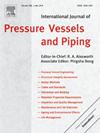Fracture toughness characterization of X52 steel - experimental and XFEM-based investigation using small-scale SENT geometry
IF 3
2区 工程技术
Q2 ENGINEERING, MECHANICAL
International Journal of Pressure Vessels and Piping
Pub Date : 2025-04-11
DOI:10.1016/j.ijpvp.2025.105529
引用次数: 0
Abstract
This study characterizes the fracture toughness properties of an API X52 vintage pipeline steel through fracture testing and extended finite element simulation of Single-Edge Notched Tension (SENT) specimens. The aims are to enhance understanding of the steel's fracture toughness, evaluate the capability of XFEM in predicting the fracture behavior of SENT specimens, and calibrate the damage parameters of XFEM for the X52 steel under study, thereby improving the integrity assessment of vintage pipeline networks. In the experimental phase, three groups of SENT specimens with different initial notch length to specimen width ratios ( 0.2, 0.3, and 0.5) were loaded until fracture. Each group of specimens consisted of three replicates to ensure reproducibility. Global displacements were measured using the load cell of the testing machine, while surface displacements, including Crack Tip Opening Displacement (CTOD) and Crack Mouth Opening Displacement (CMOD), were measured via the Digital Image Correlation (DIC) technique. To compare the tested steel's fracture toughness with that reported in other studies, the J-integral and CTOD resistance curves (R-curves) were generated using the multiple specimen technique. For this purpose, having accurate crack extension () values was critical. Hence, we devised a novel method to identify the crack tip and compared it with the crack tip observed in the images captured by the DIC system. The numerical phase involved calibrating the fracture parameters of XFEM models and comparing the Force-displacement and Force-COD outputs of the calibrated models with experimental results. It also included studying the stress triaxiality of specimens with different values and concluded with a sensitivity analysis of mesh size and damage initiation and evolution parameters. The close agreement between XFEM predictions and experimental results confirms the reliability of XFEM in predicting the fracture behavior of SENT specimens.
X52钢断裂韧性表征——基于小规模send几何的实验和xfem研究
本研究通过断裂试验和单边缺口拉伸(SENT)试样的扩展有限元模拟,表征了API X52老式管道钢的断裂韧性特性。目的是提高对钢的断裂韧性的认识,评估XFEM预测SENT试件断裂行为的能力,并对所研究X52钢的XFEM损伤参数进行校准,从而提高对老式管网完整性的评估。在实验阶段,将初始缺口长度与试件宽度之比(a0/W= 0.2、0.3和0.5)不同的三组SENT试件加载至断裂。每组标本由3个重复组成,以确保再现性。使用试验机的测力元件测量整体位移,通过数字图像相关(DIC)技术测量表面位移,包括裂纹尖端张开位移(CTOD)和裂纹张开位移(CMOD)。为了将测试钢的断裂韧性与其他研究报告进行比较,使用多试样技术生成了j积分和CTOD阻力曲线(r曲线)。为此,精确的裂纹扩展(Δa)值至关重要。因此,我们设计了一种新的方法来识别裂纹尖端,并将其与DIC系统捕获的图像中的裂纹尖端进行了比较。数值阶段包括对XFEM模型的断裂参数进行校正,并将校正模型的力-位移和力- cod输出与实验结果进行比较。研究了不同a0/W值试件的应力三轴性,并对网格尺寸、损伤起裂和演化参数进行了敏感性分析。XFEM预测结果与试验结果吻合较好,证实了XFEM预测试件断裂行为的可靠性。
本文章由计算机程序翻译,如有差异,请以英文原文为准。
求助全文
约1分钟内获得全文
求助全文
来源期刊
CiteScore
5.30
自引率
13.30%
发文量
208
审稿时长
17 months
期刊介绍:
Pressure vessel engineering technology is of importance in many branches of industry. This journal publishes the latest research results and related information on all its associated aspects, with particular emphasis on the structural integrity assessment, maintenance and life extension of pressurised process engineering plants.
The anticipated coverage of the International Journal of Pressure Vessels and Piping ranges from simple mass-produced pressure vessels to large custom-built vessels and tanks. Pressure vessels technology is a developing field, and contributions on the following topics will therefore be welcome:
• Pressure vessel engineering
• Structural integrity assessment
• Design methods
• Codes and standards
• Fabrication and welding
• Materials properties requirements
• Inspection and quality management
• Maintenance and life extension
• Ageing and environmental effects
• Life management
Of particular importance are papers covering aspects of significant practical application which could lead to major improvements in economy, reliability and useful life. While most accepted papers represent the results of original applied research, critical reviews of topical interest by world-leading experts will also appear from time to time.
International Journal of Pressure Vessels and Piping is indispensable reading for engineering professionals involved in the energy, petrochemicals, process plant, transport, aerospace and related industries; for manufacturers of pressure vessels and ancillary equipment; and for academics pursuing research in these areas.

 求助内容:
求助内容: 应助结果提醒方式:
应助结果提醒方式:


